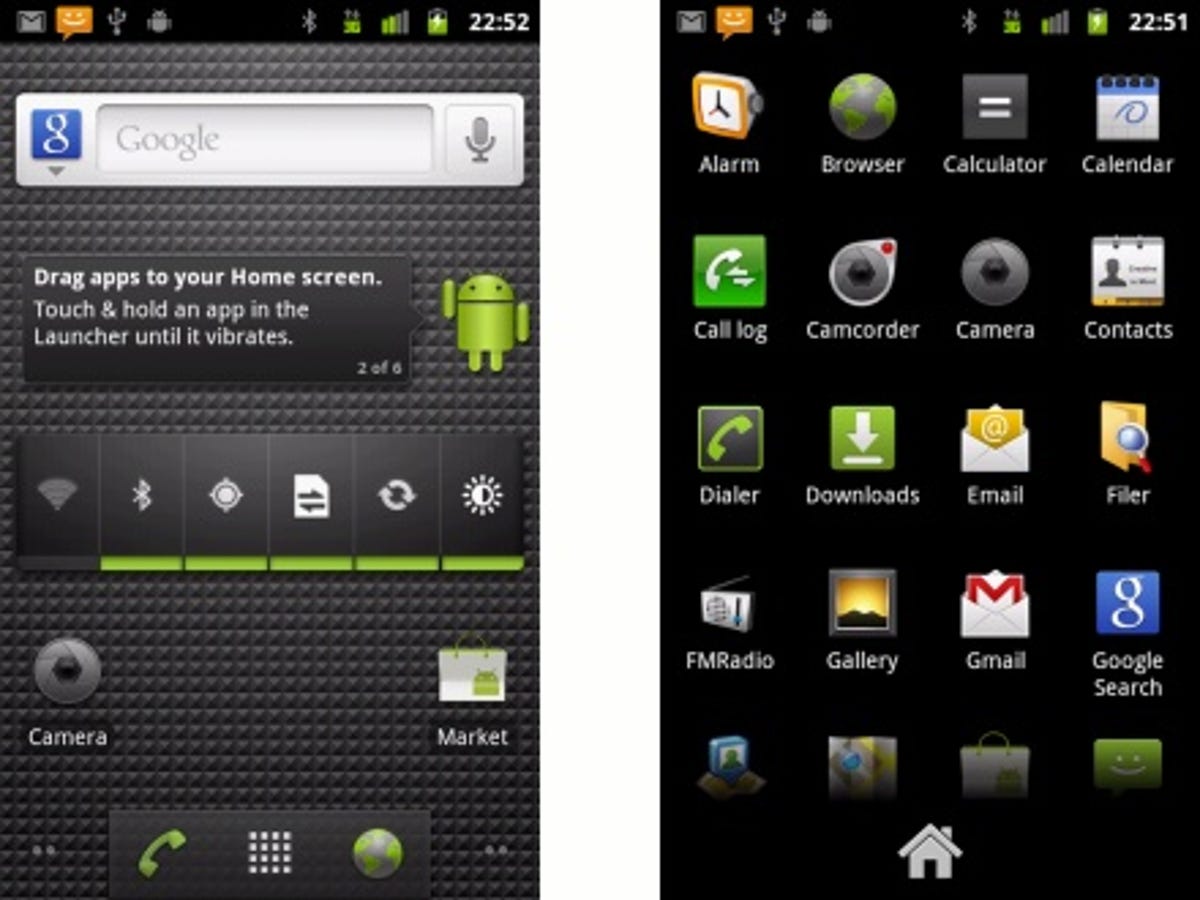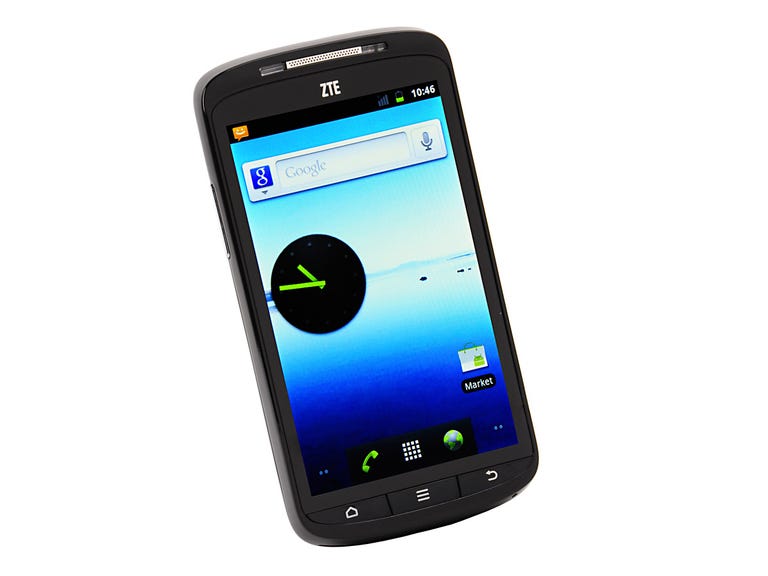 Why You Can Trust CNET
Why You Can Trust CNET ZTE Skate review: ZTE Skate
The ZTE Skate impresses with pure Android 2.3 on a massive 4.3-inch screen for a decent SIM-free price despite an under-powered CPU and dodgy build quality.
The ZTE Skate is a budget Android smartphone running version 2.3 of Google's mobile operating system. It boasts a massive 4.3-inch screen and comes with a 2GB microSD card.
The Good
The Bad
The Bottom Line
The Skate is available unlocked and SIM-free for around £200.
Should I buy the ZTE Skate?
If you read our Orange Monte Carlo review and were dissuaded by the obnoxious custom interface installed by Orange, then you may want to give the ZTE Skate some serious consideration.
The two phones are technically identical. They share the same internal hardware, the same case design and are both running Android 2.3, also known as Gingerbread. The big difference is that the Monte Carlo is being sold with Orange's software pre-loaded, while the Skate is packing the purest flavour of Android outside of the Google-backed Nexus S.

This means you don't have to contend with performance-sapping pre-loaded apps you don't need -- or bloatware -- and a lurid user interface. Instead you're granted a blank canvas on which you can make your own mark.
This will appeal to die-hard Android fans but it comes at a cost -- because the Skate is currently only being sold SIM-free, you'll have to shell out around £80 more than you would for the pay as you go Monte Carlo.
Stock Android
If we're brutally honest, we hated Orange's custom user interface on the Monte Carlo. It was unattractive, sluggish and came packed with pointless applications which couldn't be removed by the user.
The ZTE Skate is running an almost untouched version of the stock Android operating system. That means it suffers from none of these issues. Put this phone alongside the Nexus S -- which also runs pure Android -- and you'd be hard-pressed to tell the difference from a user interface perspective.
There are some changes to take note of, however. The camera application has been slightly improved, offering an on-screen brightness control; this is for those times when you're shooting in low-light and can't make out your subject on the screen. There's also a smattering of pre-loaded apps, most of which are genuinely useful and don't hog processing power.
Because the version of Android on the Skate is uncluttered and free of bloatware, it runs moderately faster and smoother than the one seen on the Monte Carlo. It's still not a totally silky experience though. Scrolling is slightly jerky and there's a noticeable delay when moving between applications or opening menus.
Despite these issues, the decision to launch the Skate with stock Android was a wise one on ZTE's part. It gives users a chance to customise the phone to their own tastes, installing things they actually want rather than having apps forced upon them.
Design
As we've already mentioned, the Skate is virtually identical to the Orange Monte Carlo. The only difference is the logo printed on the casing.
Despite its large dimensions, the Skate weighs just 120g. For a device with a 4.3-inch screen, that at first appears a remarkable achievement. It's slightly less impressive when you discover that the casing is entirely plastic -- and cheap plastic, at that.
Producing a handset of this type for such a modest budget naturally requires some sacrifices to be made. In the case of the Skate, it's construction materials. Don't go expecting the robust build quality of the Motorola Defy or the lush, highly-engineered lines of the iPhone 4S.
The front of the Skate features three physical buttons, which cover the traditional Android actions such as Home, Menu and Back. The Search button has been removed -- a habit that many Android hardware manufactures are falling into these days.
We actually quite like having a physical Search button as it allows you to quickly find items or fire up the Voice Command menu with a long-press.
Along the sides of the device you'll discover the volume rocker and power buttons. The latter is also used to lock and wake the screen. We'd hoped that you'd also be able to wake the display by pressing one of the fascia buttons, but that sadly isn't the case.
Screen
The Skate's 4.3-inch display is unquestionably one of its biggest selling points. No other budget Android phone can boast such a massive screen. The TFT LCD panel has a resolution of 480x800 pixels, which gives a pixel density of around 217 pixels per inch.
Despite lacking the vibrancy of a Super AMOLED screen, the Skate's display is reasonably bright, with good viewing angles. The auto-brightness setting is something of a miser, however, and you'll want to disable it if you hope to achieve the best image.
Of course, using such a big display does have its drawbacks, especially if you're running it on full brightness. The Skate's battery life is pretty poor, and we'd be willing to bet that a lot of the drain is down to the enormous -- but attractive -- screen.
Processing power and internal storage
Despite that massive 4.3-inch display, the ZTE Skate only has an 800MHz processor and 512MB of RAM. Other big-screen handsets that we've seen have tended to pack at least a 1GHz CPU, with plenty of RAM to aid smooth performance.
After spending a few moments with the Skate, you do get the feeling that a little extra muscle would have been welcome. The hardware seems to struggle with demanding activities. It's reduced to a crawl when you've got several things happening simultaneously.
This slowdown is nowhere near as crippling as it was on the Monte Carlo, but it will be painfully apparent to anyone who has used an Android device with a 1GHz or better processor.
The Skate has around 130MB of internal app storage space, which is pitifully small for a phone of this stature. Although you can save some of your application data to the microSD card, a small amount is always retained in the app storage.
When you consider that some apps can swallow as much as 10MB of space, it's clear that you're not going to be able to store masses of downloads on the Skate.
The phone's microSD card slot comes pre-loaded with a 2GB card, which is fairly standard practice in the Android budget sector. This amount will suit casual users, but if you intend to take photos, shoot videos and listen to music on this handset, it might be wise to upgrade to a larger card. The Skate is capable of accepting microSD media up to 32GB in capacity.
Applications and Internet
Although the ZTE is mercifully light on pre-installed bloatware, there are a few apps present. Thankfully they're ones you may actually find yourself using from time to time.
There's a file manager (still something that doesn't come as standard in the Android operating system), video player app, stopwatch and task killer. These are arguably apps you'd download anyway, so you're unlikely to begrudge their existence.
With that massive screen, you'd rightly expect the Skate to be an absolute dream when it comes to browsing the web. That's partly true, as the 4.3-inch display size allows you to view detailed websites without the need to constantly keep zooming in and out (the capacitive screen allows multi-touch pinch gestures, by the way).
Sadly, the Skate doesn't support Adobe Flash, so you won't be able to view embedded videos and other interactive media. However, with Adobe recently announcing that it is ending support for Flash on mobile devices, the lack of compatibility on the Skate could end up being a non-issue.
Camera and video recording
The Skate has a 5-megapixel auto-focus camera with LED flash. Image quality is passable, but the same issues that afflict many mobile phone cameras are present here.
Images often lack colour, and when you're shooting in anything but perfect sunlight, the results are dim and dull.
Also, the LED flash is far too powerful and overexposes almost all shots taken in dark environments.
Video recording is similarly unimpressive. There's no trace of HD capture, and instead the phone is limited to 640x480-pixel resolution. As you might expect, this yields fuzzy, ill-defined footage that looks terrible on any screen larger than the one on your mobile.
Connectivity and Battery life
With 2G, 3G and Wi-Fi all covered, the ZTE Skate is a well-connected handset. There's also support for Bluetooth file transfer and device connectivity, so you can wirelessly pair your Bluetooth headset with this phone for the ultimate hands-free experience.
Because it's running the latest version of Android, the Skate can also act as a portable Wi-Fi hot-spot, meaning you can tether other Wi-Fi devices to the phone. This allows you to get online on tablets and other media players, but be wary of soaking up too much of your contract's monthly data allowance.
The Skate's 1,400mAh rechargeable power cell is a bit of a let-down. The phone struggled to last 24 hours without a charge. The fact that we'd pumped up the screen brightness to maximum probably didn't help.
It's tempting to drop the brightness down to conserve power but the display ends up looking disappointingly dark as a result.
Conclusion
When we reviewed the Orange Monte Carlo, we were impressed that ZTE had managed to include a wide range of features in such a cheap device. The same naturally applies to the Skate, as it's the same phone in all but name, and a slightly different user interface.
The 4.3-inch screen makes a world of difference when it comes to usability. There's no comparison when you put it alongside rival budget handsets. We're also very pleased that ZTE has included Android 2.3 (and the stock version, to boot), especially when you consider many of Samsung's low-cost phones are stranded on 2.2.
Of course, there has to be a catch. In the case of the ZTE, there are several. The 800MHz processor feels sluggish and there's not enough app storage space for serious users. The cheap, glossy casing is also likely to put a few people off.
Another big sticking point with the Skate is that it's currently only available SIM-free, which means you'll have to pay more than the £120 the Monte Carlo retails for. While the rough guide price of £200 is still excellent value for money, it does place ZTE's phone slightly outside impulse purchase territory.
Regardless of this, the ZTE Skate is a solid purchase for serious Android fans who can't afford an expensive SIM-free phone like the HTC Sensation XE or the Samsung Galaxy S2 -- both of which will cost over twice as much outside of a contract.
No other low-cost phone can offer such an expansive screen and such a clean, uncluttered version of Android as this -- it's just a shame that it wasn't given a little more power under the bonnet.


